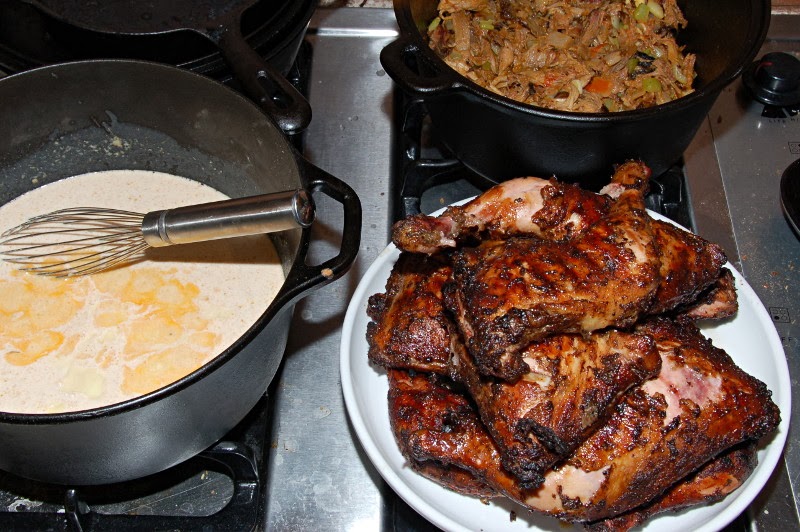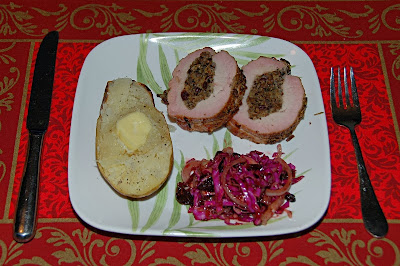Ribs

I shared some ribs with a friend recently and he told me he really enjoyed them. I said that he could do that himself and wouldn't have to wait for me to decide to share again. He thought it involved too much skill and technique. I disagree, but I've been doing this for years. The purpose of this post is to describe my process so any reasonably competent cook can follow it. There is really a lot of margin in the process and I'll try to identify any points I think are critical.
Equipment
I really love my Weber Smokey Mountains. They are awesome smokers but they are expensive and you really have to be dedicated to spend $300 on one. (If you decide to go that way, I recommend the middle size 18 1/2" as the most useful.) I just checked Craigslist and there are two for sale. That compares to a couple dozen kettles.The Kettle
The kettle is the original Weber (slightly modified from George Steven's original design.) It remains the most versatile cooker. I prefer it for ribs because grate area is what counts. I like to use my 26" kettle for ribs but the 22" will do the job. I see them on Craigslist for $15 and up. (You can recognize the 22" because it has the lid vents in line with the handle instead of to the side of the handle.)Charcoal
For smoking on the kettle I use KBB. That's code for Kingsford Blue Bag. Plain old charcoal. Not matchlight! (Unless you like the taste of petroleum accelerants.) KBB provides a consistent burn. Stick with that unless you are confident in another brand.
Smoking wood
This is not required but I think it adds a nice flavor. It can also add too much flavor. A couple pieces of hickory, maple, apple and/or oak will do. They can be about the same size as the briquettes. wood chips work too but I prefer chunks. I don't bother to soak the wood in water. Wood is waterproof. They make boats out of wood.
If you have no smoking wood handy, don't worry. The ribs will still be good with just plain charcoal. (And less likely to be oversmoked.)
Fire
No charcoal lighter fluid! I use paper in a Weber charcoal chimney. (Don't cheap out and buy a knock off that won't work as well.) I use the small Weber chimney for this because I only need to start a big handful of charcoal.
An alternative is a big weed burner. I'm talking with the kind with a 4" burner tip and hose that attaches to a 20 lb. propane tank. You listen to the combustion roar when lit and you know it's going to light charcoal! You can also use an ordinary propane torch but it is not nearly as dramatic.
Meat
I think back ribs are going to be the easiest. You may also run across baby back ribs but those are going to be pricey and not really necessary. The whole point of BBQ is to take tough and otherwise useless pieces of meat and make them good. I find spare ribs a little tougher (pun intended) to get right. Country ribs are just a pork butt sliced up. I don't recommend them. (You can do a whole butt on the kettle but that's something entirely different.) I find nice meaty back ribs at Sam's Club. They come 3 to a Cryovac pack which works well on my 26" kettle. For a 22" kettle two racks of back ribs are enough.
Rub
I mix a bunch-O-spices and grind them in a retired coffee grinder. (The one shaped like an oval beer can.) You could just mix ground spices and be just as well off. Here's my mix.
2 Tbsp black pepper corns
2 Tbsp whole dried Rosemary
1 Tbsp sea salt
1 Tbsp whole Coriander
1/2 Tbsp whole Cumin
1 Tbsp whole Mustard
Grind up dry spices
1/2 tsp cayenne
Some times I add some Ancho chili for a more Southwest flavor. Go easy on the cayenne if you don't like the heat. Add/subtract to your preference. This is not a lot of cayenne because I cook for our grandchildren. I get a kick out of seeing the youngest in his high chair with a rib in each fist. :D Seasoning is one of those areas where you can be flexible and experiment. I did some testing with a variety of commercial rubs (which are often heavy on sugar and salt) against my rub. I left some ribs unseasoned. They were all good, even the ones with no seasoning (though I would recommend at least some pepper and a little salt at a minimum.)
Sauce
I don't sauce the ribs in the cooker. Some times I sauce them a little when I reheat them. You can sauce them toward the end of the smoke if you want. I like Sweet Baby Ray's plain sauce but there are many other good sauces. Of course a little spritz of Louisiana Hot sauce or Tabasco at the table is good if you like a little more heat.
Process
Prep the ribs
First thing I do is unwrap the ribs. Flip them over and try to peel the membrane off the back. Stick something like a bamboo skewer or spoon handle under the edge to get it started and grab it with some paper towel to get a grip and peel it off. If it doesn't come off easily, just leave it in place.
Apply the rub to both sides of the ribs. The recipe above is about right for three racks of back ribs or two of spares. They come out kind of like herb crusted ribs. I like that. If you don't, use less rub. It's not critical. The ribs sit with the rub on them while I get the fire going.
Fire Lay
I use a charcoal arrangement that is called the snake. I put a wide row of charcoal about 2/3 of the way around the charcoal grate. I do this about 4-5 briquettes or so wide. Think of that as three briquettes next to each other on the bottom and two set on top of them. I used to carefully arrange them but lately have gotten too lazy to do that. They still burn. The wider the 'snake' the hotter it will burn. Don't worry if you don't get it exact. Ribs tolerate a range of cooking temperatures. 200° F to 375° F will work and just result in different cooking time. Add a half dozen chunks of smoking wood spaced along the back of the snake and the fire is set. I also put a foil pan on the charcoal grate to catch some of the grease that will come off the ribs. You can make a tray with several layers of foil.
Light the charcoal at one end. Either light 6-8 in a chimney or aim your flame thower at one end of the snake for a half minute. The point is to start the fire at one end of the snake, not to get all of the charcoal lit. This controls temperature by limiting how much fuel burns at one time.
Open all vents completely to start. Closer to the end of the cook when the meat is hot and more of the charcoal is burning, you can close the lid vent a little to moderate temperatures. If your kettle has a lid thermometer, look for a temperature from 250-350° F. The snake will normally run at the lower end of that range. Here's a double snake that will run a little hotter.


Meat on!
My favorite part. Wait... meat off is my favorite, this is my second favorite. Arrange the racks on the grate with the end with the thickest meat toward the lit charcoal. If space is tight you might have to overlap racks but understand they will probably take a little longer to cook. When I do that I also rearrange them every hour or two to get more even cooking. Some times I flip them over for a bit too. I start ribs with the bones arched up (membrane side down.)
Put the lid on and orient the vent opposite the lit charcoal.
Cook
Resist the temptation to open the cooker and peek. It doesn't help them cook. Check after an hour or two and perhaps every hour after. When the ribs are near done, you might want to check every half hour or 20 minutes. There are strategies that involve wrapping the ribs in foil but I do not do that. Ribs steam in the foil and I want mine smoked.
When are they done?
If not cooked long enough, the meat will be tough but still tasty. If cooked too long, they may be falling off the bone. The ribs will usually pull back on the bones about 1/2" before they are done. At lower cooking temperature (below about 225° F) they may not pull back. Pick the rack up at one end with tongs and they should be somewhat floppy when done. If you get them off too soon and find them tough, stick them in the oven at 275° until done. The smoked flavor is there and will not evaporate in the oven.
They should be done in about 5 hours. It will vary depending on cooker temperature.
Do your homework
Take notes. Record what you liked, what worked well and most important, what you would do next time to make better ribs. If they don't come out perfect the first time, don't give up. Just do better. That is actually the primary purpose of this blog. I used to record in detail all of my cooks so I could reflect and do better next time. I recommend you do something similar.
Postscript
The first thing I ever cooked on a Weber kettle was back ribs. They came out so good I remember them to this day, over 4 decades later. I got good results by following the instructions that came with the cooker. You could do that too. I'm sure Weber publishes that information on line.


















